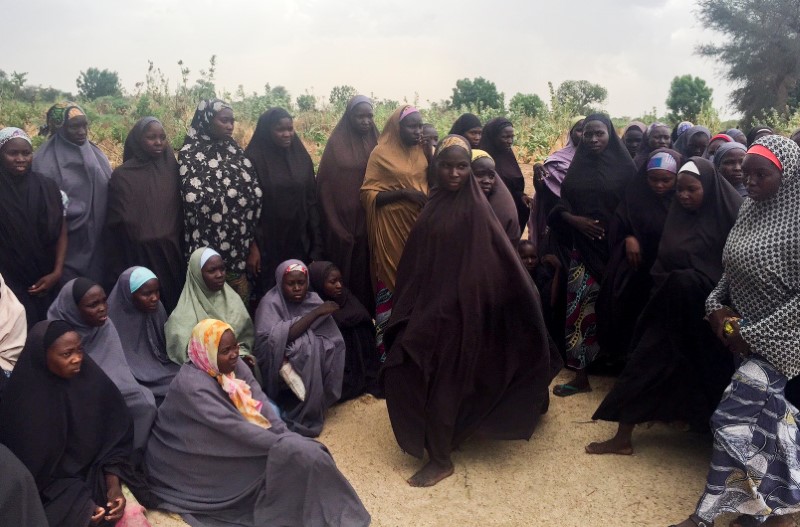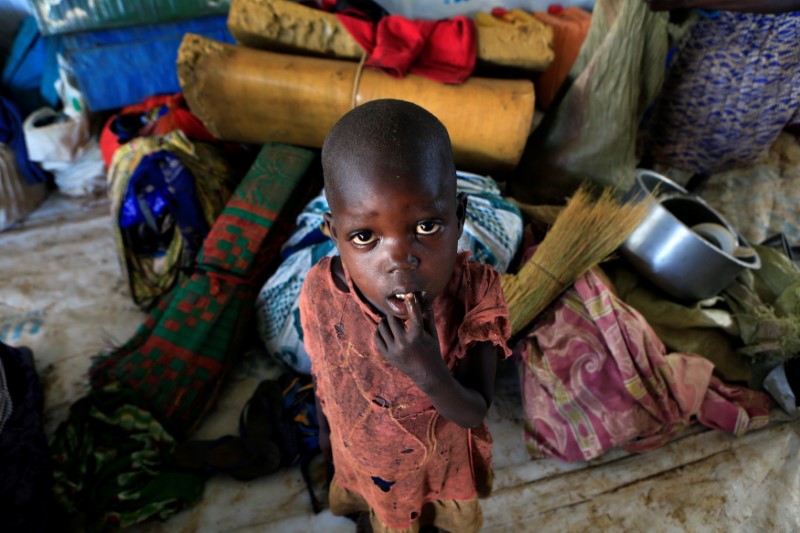
By Alexis Akwagyiram
BANKI, Nigeria (Reuters) – When he heard that the Nigerian army had declared his family’s home town of Banki free from Boko Haram militants and safe to return, Bukar Abdulkadir did all he could to bring his family back to the place they had fled three years ago.
It took nine months of hunger, selling most of the food rations they received at their refugee camp in Cameroon, to save up for the cost of a two-day journey in a lorry container back across the border into northern Nigeria.
But instead of returning to till the familiar fields of home, they came back to a desolate wasteland littered with the rubble of destroyed buildings and burnt cars, where they were herded into a crowded camp by soldiers.
The once thriving town, which the army retook in September 2015, has been razed to the ground. Along with some 32,000 other homeless inhabitants, Abdulkadir’s family are now confined to the camp amid the ruins, guarded by troops who do not let them out unescorted, officially to protect them from explosives strewn across farmland.
“I can’t provide for my family because I can’t farm,” said Abdulkadir. “If the market opened I could do something to make their lives better,” he added in a voice cracking with emotion as he gazed at his children.
Nigeria’s security forces have succeeded in recapturing most of the territory once held by Boko Haram Islamist militants after years of an insurgency in which civilians were often the targets. But instead of bringing a joyous end to the conflict, the victories have revealed communities gripped by hunger.
Some 4.7 million people in northeast Nigeria depend on food aid, some of which is blocked by militant attacks, some held up by a lack of funding and some, diplomats say, stolen before it can reach those in need.
Millions of Nigerians may soon be in peril if the situation deteriorates, as authorities expect, when the five-month rainy season begins in May and makes farming impossible in areas that are now accessible.
This part of Nigeria is the western edge of an arc of hunger stretching across the breadth of Africa through South Sudan, Somalia and into Yemen on the Arabian peninsula. The United Nations believes as many as 20 million people are in danger in what could become the world’s worst famine for decades.
ALREADY BROKEN
“This camp is already broken,” said a field worker responsible for food distribution to children at the camp in Banki, asking not to be identified while he discussed the conditions endured by residents of the destroyed town.
Three hundred women and children were queuing for water in the scorching sun. Fatima Mallam, a widowed mother of three, said she had to wait five hours. The field worker said that was now normal for the camp. There are only 14 working boreholes to provide water for the 32,000 people.
“When the rainy season comes there is likely to be an outbreak of cholera and other diseases because people defecate in the open,” the worker said.
Lured by news of the army retaking territory lost to Boko Haram, some 152,000 people like Abdulkadir and his family have returned from neighboring Cameroon and Niger since the start of the year, according to the U.N. refugee agency.
But as Boko Haram continues to stage suicide bombings and hit-and-run attacks, most end up in already stretched camps unable to resume farming, the main activity in the northeast.
Thousands of others are arriving in camps daily from parts of the northeast where the army, aided by troops from neighboring countries, has pushed the Islamist militants out of most of the territory they controlled until early 2015.
At another northeastern camp, in Gamboru-Ngala, army units were trying to accommodate a new influx of thousands.
“We only have four nurses and one medical doctor to cater for this number of people so it is not enough to deal with their medical challenges,” said Army Lieutenant Colonel Patrick Omoke.
“There is no secondary health facility in the whole of Ngala local government,” he said. “A lot of people come in – shelter is a major challenge now.”
Aid agencies and military officials say the rainy season, beginning in the next few weeks, will make many roads impassable, increasing the dependence on food aid as farming halts and the movement of goods becomes restricted.
Cesar Tishilombo, who heads the sub-office of the U.N. refugee agency in Maiduguri, a state capital, said up to three million people were at risk of famine in areas recently recaptured from Boko Haram. Aid agencies working in Nigeria faced a funding crisis, he said.
“The pledge has been $1 billion plus. People have pledged but the promises are not translating into cash,” he said, adding that his agency had received just $11 million of the $70 million it had requested.
Western diplomats say corruption and government mismanagement are partly to blame for the failure of aid to reach those in need.
“Nobody knows who is in control,” said one diplomat, describing overlapping systems of authority at the local, state and federal levels that make it difficult to organize aid.
“There is corruption at every level, from drivers up to state and federal government,” said another diplomat, adding by way of example that 12 trucks might leave a depot with food aid and only two arrive at distribution centers to feed the hungry.
A spokesman for President Muhammadu Buhari declined to comment on the assertions of corruption in aid deliveries, but the president has acknowledged that graft is a serious problem hindering recovery in areas recaptured from the militants.
Last month the authorities launched an investigation into allegations that funds allocated to contractors to help rebuild the insurgency-hit region had been misused. The presidency said the investigation was linked to another probe into $43 million in cash found in a flat in the commercial capital Lagos.
(Additional reporting by Felix Onuah and Paul Carsten in Abuja; editing by Peter Graff)













